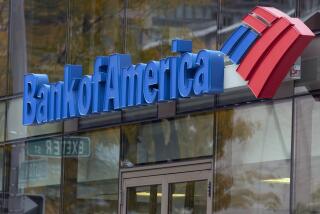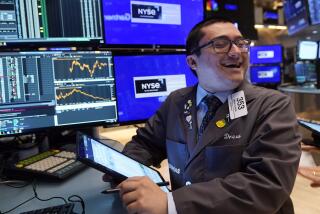A computer glitch distorts Dow’s drop, then exacerbates it
NEW YORK — A computer glitch at Dow Jones & Co. late in Tuesday’s stock market session made it erroneously appear as though the closely watched Dow Jones industrial average had plunged nearly 200 points in a matter of seconds -- shocking traders and adding to the fear and confusion of an already chaotic day.
The glitch sparked a cascade of sell orders at the New York Stock Exchange and other markets, causing delays in execution of trades and a choppy end to the trading session.
Dow Jones’ troubles started about 2 p.m. Eastern time when computer systems were apparently overwhelmed by trading volume, causing the calculation of the widely watched industrial average and other Dow Jones indexes to lag behind trading, spokeswoman Sybille Reitz said.
Once Dow Jones realized that the indexes were lagging -- that is, not properly reporting the extent of the market’s decline in real time -- executives notified the exchanges by phone.
About 3 p.m., Reitz said, Dow Jones switched from its primary server to a backup system, which rapidly caught up with the trading. The result was that an extended period of trading, perhaps the better part of an hour, was reported to the market in a matter of seconds, she said, making it appear as though the Dow Jones industrial average had lost nearly 200 points almost instantaneously. At one moment, the Dow seemed to be down about 280 points; when traders glanced back at their screens, it was down more than 450 points.
That seemingly unprecedented swoon apparently sparked some panic selling that in turn caused a logjam at the NYSE and other markets amid a high volume of trades.
In that last hour of trading, “the pipelines got filled,” causing delays in executing orders, exchange spokesman Rich Adamonis said. Some orders that normally would have been executed electronically were done manually, he said. The delays are being investigated, Adamonis said, but “it looks like it was system-capacity related.”
The Big Board at the end of every trading day has an after-hours “crossing session” during which specialists and traders catch up with delayed orders. Because of Tuesday’s late problems, the crossing session, which generally lasts about 45 minutes, was extended by half an hour, Adamonis said. Thus, the day’s trades weren’t finally “cleaned up” until after 5 p.m., he said.
Reitz said that according to Michael A. Petronella, president of Dow Jones indexes and ventures, investment products pegged to the Dow were not affected by the glitch.
She said it had not been determined as of Tuesday evening whether the trading came in such a high-volume burst that it exceeded the capacity of the company’s computers, or whether the glitch was caused by some other factor.
The surge in volume led to trading delays at several online-brokerage firms, including Charles Schwab & Co., TD Ameritrade and Fidelity Investments, according to Keynote Systems, a San Mateo, Calif.-based company that tracks website performance.
It normally takes about 10 to 15 seconds to log on to a broker’s website, get a price quote and execute a trade, said Abelardo Gonzalez, a Keynote Internet consultant. That rose to about 25 seconds on average after 1:30 p.m. Eastern time Tuesday, and took as long as a minute at some sites, he said. And the percentage of transactions that did not go through, requiring the investor to reenter the trade, rose to about 25%, up from 5%, he said.
Such delays can be costly, especially in a turbulent market.
“For customers, having to wait an extra 10 to 30 seconds can affect the bottom line,” Gonzalez said.
*
Times staff writer Walter Hamilton contributed to this report.
More to Read
Inside the business of entertainment
The Wide Shot brings you news, analysis and insights on everything from streaming wars to production — and what it all means for the future.
You may occasionally receive promotional content from the Los Angeles Times.










